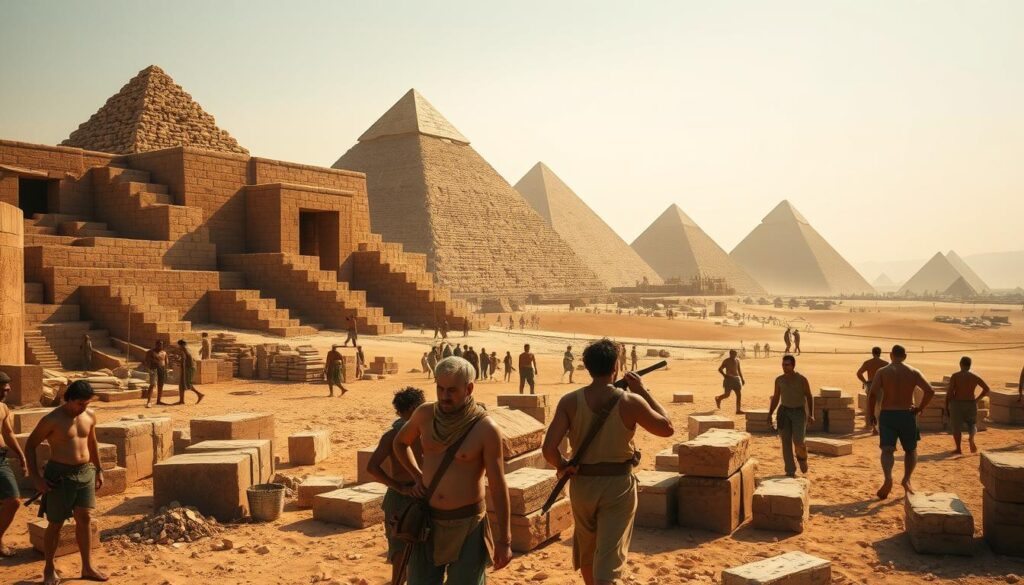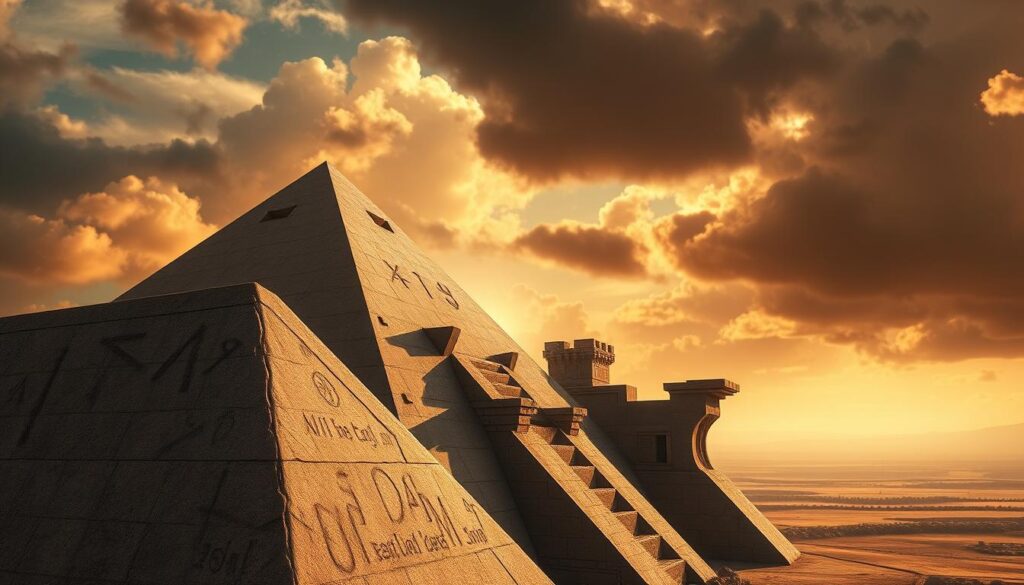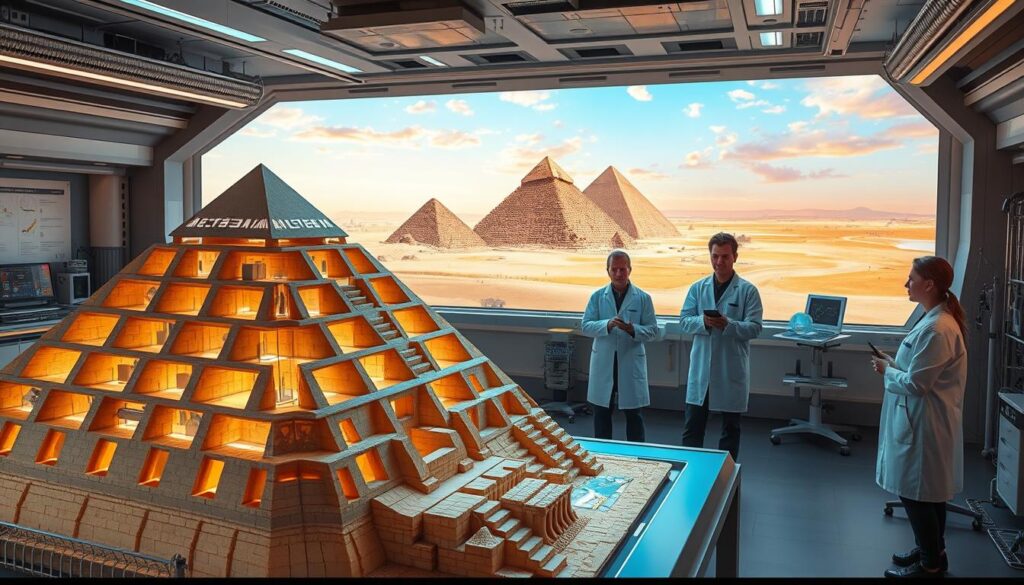The massive stone structures of Egypt have puzzled experts for centuries. How did ancient pyramid builders create such perfect monuments without modern tools? This mystery has led many to ask: did aliens help build the pyramids? The Great Pyramid of Giza stands as a marvel of precision – its base is level with an error margin of just 2.1 cm despite covering 13 acres.

The pyramid alien theory gained popularity in the 1960s. Authors like Erich von Däniken suggested extraterrestrial beings might have guided ancient civilizations. This idea spread through books, TV shows, and movies, becoming a fascinating alternative to traditional archaeological explanations.
Today, this debate continues between mainstream scientists and those who see signs of otherworldly influence. The pyramid mystery touches something deep in our human psyche – our need to explain the seemingly impossible and connect with our distant past.
Key Takeaways
- The Egyptian pyramids showcase extraordinary precision that still impresses modern engineers
- The question “did aliens help build the pyramids” remains popular in American culture
- Ancient pyramid builders achieved remarkable feats without modern technology
- The pyramid alien theory emerged in the 1960s and continues to fascinate people worldwide
- Both conventional archaeological explanations and alternative theories deserve examination
- Ancient civilizations demonstrated advanced mathematical and astronomical knowledge in pyramid construction
The Magnificent Pyramids: Ancient Wonders That Defy Explanation
The ancient pyramids of Egypt are a marvel of human creativity. They are surrounded by Egyptian pyramid mysteries that still puzzle experts today. These huge structures have amazed people for thousands of years. Their construction seems impossible, given the technology of their time.
The Scale and Precision of Ancient Egyptian Pyramids
The Great Pyramid of Giza was once 481 feet tall. It was made from over 2.3 million stone blocks, each weighing between 2.5 and 80 tons. What amazes modern engineers is how precise it is. It’s aligned to true north with an error of just 0.05 degrees, a task hard even with today’s tools.
Remarkable Engineering Feats Without Modern Technology
The ancient pyramid technology is seen in the internal chambers and hidden passageways. These were built without power tools or modern equipment. The granite blocks in the King’s Chamber were cut so precisely that a credit card can’t fit between them.
The builders also achieved perfect level foundations across 13 acres. They kept their accuracy to within fractions of an inch.
The Timeline of Pyramid Construction
Most Egyptian pyramids were built between 2686-1650 BCE. This was a construction boom that lasted nearly a thousand years. The pyramid construction methods evolved over time, from step pyramids to perfect geometric shapes.
This timeline shows how advanced these structures were. They were built in an era when most civilizations had not yet developed basic writing systems. This makes their architectural skill even more remarkable.
Conventional Archaeological Explanations for Pyramid Construction
The Great Pyramid at Giza needed about 2.3 million stone blocks. Each block weighed between 2.5 and 15 tons. These huge structures were built by skilled Egyptian craftsmen, not slaves. The ancient pyramid builders worked in teams, each focusing on a different part of the construction.
Archaeologists found worker villages near Giza. These villages housed thousands of laborers. This shows that pyramid construction methods got better over time. The first attempts were simple mastaba tombs. These then evolved into step pyramids under Pharaoh Djoser, and later into the smooth-sided pyramids we know today.
Experts think that large limestone blocks were cut using copper chisels and dolerite pounders. These stones were moved on wooden sledges over wet sand. This made moving them much easier, reducing friction by up to 50%. Workers used levers to place the blocks and built huge ramps that wrapped around the pyramid as it grew.
New discoveries are shedding light on Egyptian pyramid mysteries. Archaeologists found papyri at Wadi al-Jarf that talk about food for workers and how to move things. They also found remains of ramps and marks on blocks. These show how these ancient engineers built the pyramids.
| Construction Element | Archaeological Evidence | Modern Interpretation |
|---|---|---|
| Stone Quarrying | Tool marks, unfinished quarries | Copper tools, dolerite pounders, leverage techniques |
| Transportation | Sledge remnants, rope marks | Wooden sledges on moistened sand pathways |
| Lifting Methods | Ramp remains, lever sockets | Combination of ramps, levers, and counterweights |
Did Aliens Help Build the Pyramids? Examining the Popular Theory
For decades, the idea that aliens helped build the Great Pyramids has intrigued many. This idea, known as the pyramid alien theory, suggests ancient humans couldn’t have built such wonders alone. It proposes that they needed help from beings from another world.
Origins of the Ancient Astronaut Theory
The ancient astronaut hypothesis started in the mid-20th century. In 1968, Swiss author Erich von Däniken’s book “Chariots of the Gods?” sparked a lot of debate. He argued that aliens visited Earth long ago and shared their knowledge with early humans.
Von Däniken believed the pyramids’ precision and scale showed aliens helped ancient people. This was something their technology couldn’t have done on its own.
Key Proponents and Their Claims
Many have supported the idea that aliens helped build the pyramids. Zecharia Sitchin thought ancient Sumerian texts talked about aliens called Anunnaki. They came to Earth for resources, he said.
Giorgio Tsoukalos, known from TV, points out the incredible precision of the pyramid stones. He believes this shows aliens used advanced technology.
The Great Pyramid of Giza contains enough stone to build a wall around France, yet its blocks fit together with gaps narrower than a credit card – an achievement that challenges explanation even today.
Analyzing the Appeal of Extraterrestrial Explanations
The did aliens help build the pyramids question fascinates us because it taps into our curiosity about the past. These theories offer simple answers to complex questions. They make it seem like ancient people had help from beings beyond our world.
The pyramid alien theory fills in the blanks of history, especially when we see engineering feats that seem impossible. It’s a story that connects us to our ancestors and the idea that they got help from the cosmos to achieve greatness.
Mysterious Elements That Fuel Alien Pyramid Theories
The pyramids have puzzling features that challenge our understanding of ancient civilizations. These unexplained pyramid features lead to theories of otherworldly help.
Unexplained Technological Achievements
The cutting of massive granite blocks, up to 70 tons, is hard to explain. Many blocks fit together with gaps smaller than a credit card. This is a challenge even with today’s technology.
The inner chambers of the Great Pyramid keep a constant temperature, no matter the weather outside. This shows advanced knowledge of thermal control. It makes us wonder how these structures were built with copper tools and stone hammers.

Astronomical Alignments and Mathematical Precision
The Great Pyramid aligns with true north with an accuracy of 0.05 degrees. This precision suggests knowledge of stars and math, typical of later civilizations. The structure also encodes mathematical constants like pi and the golden ratio in its design.
The three main Giza pyramids mirror the alignment of Orion’s belt stars. This correlation is seen as pyramid extraterrestrial evidence by many.
Similarities Between Pyramids Across Different Cultures
Pyramid structures are found across ancient civilizations:
- Egyptian pyramids (Africa)
- Mayan and Aztec pyramids (Central America)
- Chinese pyramids (Asia)
- Nubian pyramids (Sudan)
These cultures, without known contact, built similar structures with astronomical alignments. This global phenomenon supports theories of a shared influence, possibly of extraterrestrial origin.
Ancient Texts and Artwork: Evidence of Extraterrestrial Contact?
Egyptian temples and tombs hold artwork that some see as proof of alien contact. The “helicopter hieroglyphs” at the Temple of Seti I in Abydos look like modern aircraft. This has sparked a lot of debate about aliens in ancient Egypt.
These carvings seem to show helicopters, submarines, and advanced vehicles. It’s hard to believe ancient people knew about these without outside help.
The Dendera “light bulb” relief is another mystery. It shows a modern electrical device with what looks like a filament inside. Fans of the ancient astronaut theory say this is evidence of advanced technology from aliens.
Egyptian texts tell of gods coming from the sky in “boats of the sky” and sharing knowledge. These stories gain new meaning when seen as possible alien contact. They describe beings living for thousands of years with incredible powers, like advanced visitors.
But traditional archaeology has other ideas. They say the “helicopter” might be from re-carved hieroglyphs, looking like modern objects by chance. The “light bulb” could be about lotus flowers and serpent symbols in Egyptian myths. Still, the visual similarities keep sparking interesting talks about ancient alien encounters.
Scientific Analysis: What Modern Research Reveals About Pyramid Construction
Recent studies have changed how we see the ancient pyramids’ construction. Scientists use new tech to uncover secrets of these huge structures. The find of worker logs at Wadi al-Jarf has shed light on moving limestone blocks to Giza, debunking old myths about pyramid construction methods.

Archaeologists have found ramps at many pyramid sites. This proves how ancient pyramid builders lifted huge stones. Ramps and tool marks on stones show the exact methods used. Computer models show Egyptian methods were not only possible but also very effective.
Experiments have shown that ancient Egyptians could build pyramids with their tools. Teams have moved and placed heavy blocks using ancient methods. These tests prove that ancient people could achieve these feats without modern tools.
Methods like radiocarbon analysis and thermoluminescence have given us a clearer timeline for pyramid building. These methods show pyramids were built during Egypt’s technological peak. The evidence supports human creativity, not outside help, in building these wonders.
The Cultural Impact of Alien Pyramid Theories in American Society
The pyramid alien theory has become a big deal in America. It’s moved from being a weird idea to a popular topic. Now, many people wonder if aliens helped build the pyramids.
Representation in Popular Media and Entertainment
Hollywood loves the ancient astronaut hypothesis. Movies like “Stargate” and “Indiana Jones and the Kingdom of the Crystal Skull” show aliens helping ancient people. TV shows like “Ancient Aliens” have been exploring these ideas since 2009.
Video games like “Assassin’s Creed” also include aliens in their stories. This shows how aliens are a big part of our entertainment.
How These Theories Shape Public Understanding of Ancient History
These theories have changed how people see ancient history. A 2018 survey showed 35% of Americans think aliens helped ancient people. This has made people more interested in archaeology.
But it also makes us forget the amazing things ancient humans did. Online groups and conventions about aliens and pyramids are very popular. They show how curious and open to new ideas Americans are.
Why the Alien Pyramid Connection Continues to Captivate Our Imagination
Many people are still fascinated by the idea that aliens helped build the ancient Egyptian pyramids. This fascination shows our deep desire to understand the mysterious. It also reflects our hope that we’re not alone in the universe.
The theories about alien involvement in pyramid construction spark our sense of wonder. They make us think about our place in the world and the universe. These ideas suggest we might be part of a larger cosmic community.
We shouldn’t just ignore these theories. They are a modern myth that helps us appreciate the ancient Egyptians’ achievements. The mystery of the pyramids will keep inspiring us. It encourages us to explore both science and the wonder of these ancient marvels.
FAQ
What are the key claims of the ancient astronaut theory regarding the construction of the Egyptian pyramids?
The ancient astronaut theory says aliens might have helped build the Egyptian pyramids. It claims humans couldn’t have done it with ancient tech. It points out the pyramids’ advanced math and astronomy, and how they were built.
What are some of the major mysterious elements of the pyramids that fuel alien pyramid theories?
The pyramids’ alignment with stars and their math are seen as alien clues. Their flat surfaces and tight joints are also puzzling. The ability to cut hard stones with old tools is another mystery.
Pyramids in Egypt, Mesoamerica, and Asia look similar. This similarity supports the idea of alien help.
How have ancient texts and artwork been interpreted to support the idea of extraterrestrial contact in ancient Egypt?
Ancient texts and art are seen as proof of alien visits. The “helicopter hieroglyphs” and “light bulb” relief are examples. But, experts say these can be explained by ancient stories and symbols.
What do modern scientific and archaeological research reveal about the construction of the Egyptian pyramids?
New research shows how the pyramids were built. Worker logs and tool marks have been found. Engineering studies prove ancient methods were possible.
Modern dating has also helped us understand when the pyramids were built. This places them in the context of ancient Egypt’s tech.
How have theories about aliens building the pyramids impacted popular culture and public understanding of ancient history?
Aliens building the pyramids is a big idea in American culture. It’s seen in movies, TV, and books. This idea has shaped how people see ancient history.
While it’s interesting, it can also hide the real achievements of ancient humans. It can also make people less interested in real history.
